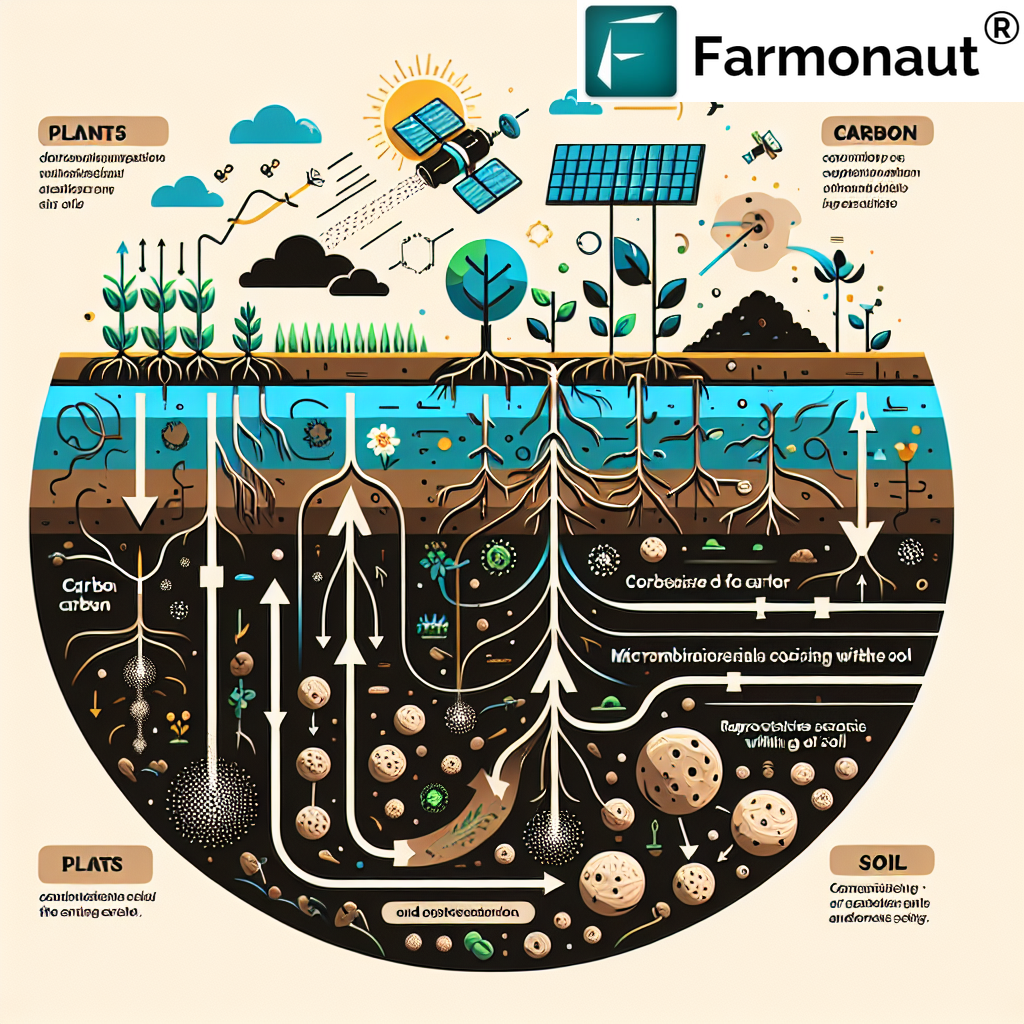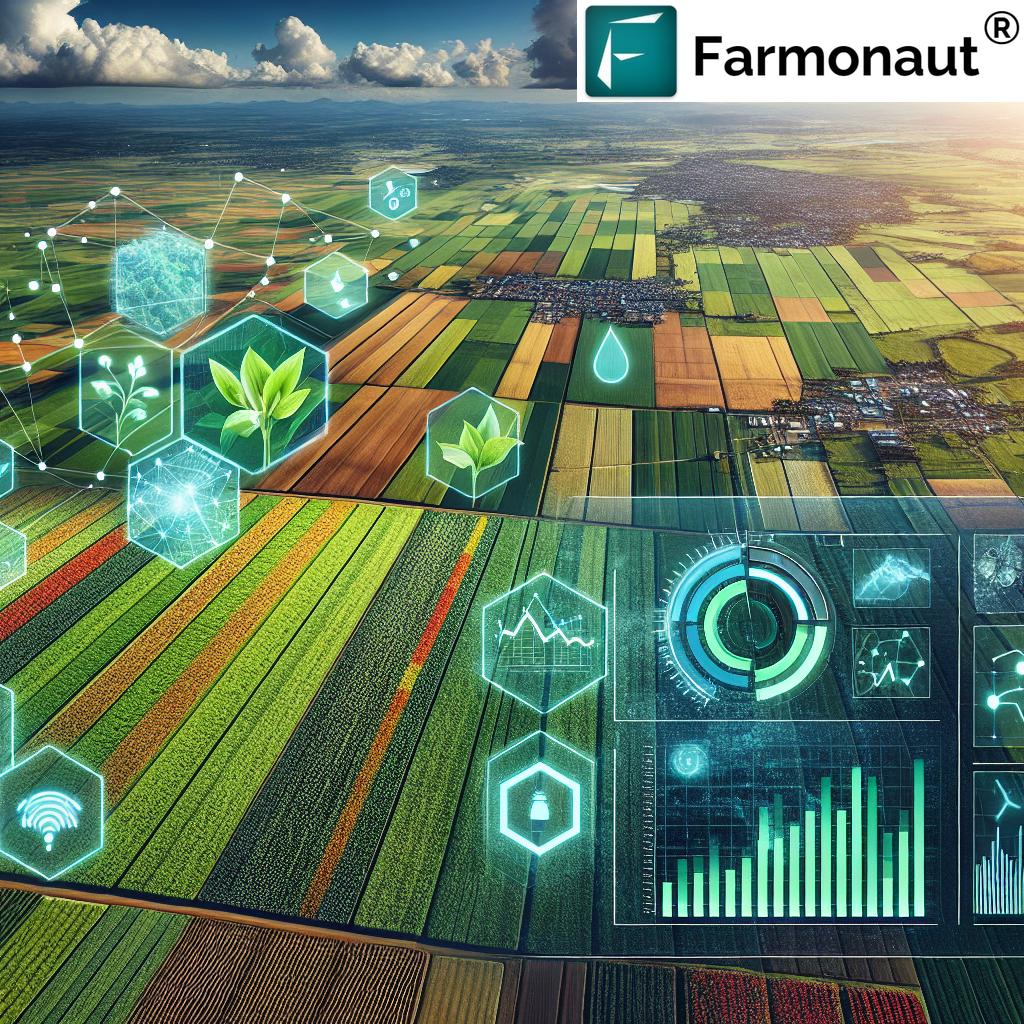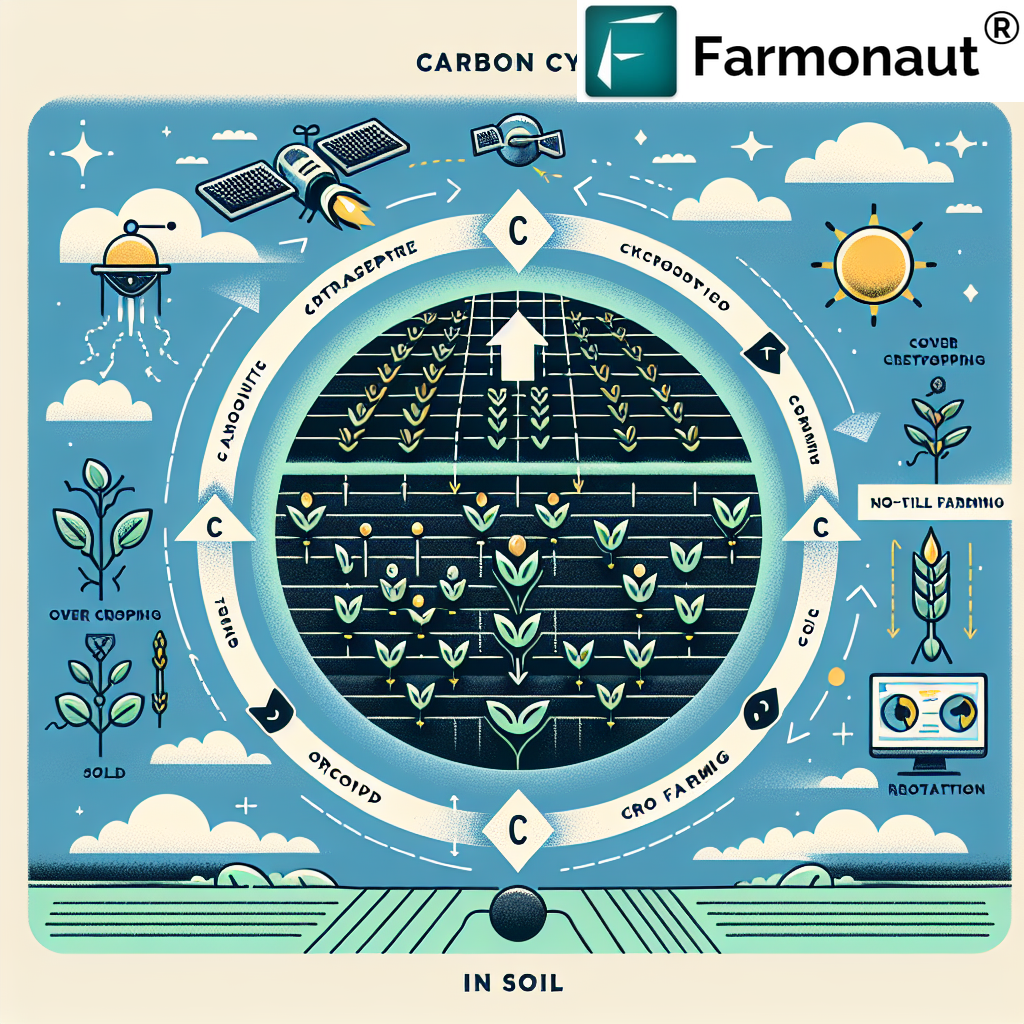Revolutionizing Sheep Farming: How eID Technology Boosts Productivity and Precision in Livestock Management
“eID technology in sheep farming can involve up to 3 types of devices: handheld scanners, panel readers, and integrated weighing systems.”
In the ever-evolving world of agriculture, we’re witnessing a remarkable transformation in livestock management, particularly in sheep farming. The advent of electronic identification (eID) technology has ushered in a new era of precision and efficiency, revolutionizing the way we track, manage, and optimize our flocks. At Farmonaut, we’re excited to explore this cutting-edge technology and its profound impact on the pastoral industry.
As we delve into the world of eID equipment for sheep farming, we’ll uncover how these smart farming solutions are reshaping productivity, enhancing animal welfare, and boosting profitability for farmers across the globe. From simple handheld scanners to sophisticated integrated weighing systems, we’ll guide you through the various types of eID devices available and help you understand how to choose the right system for your farm’s unique needs.
Understanding eID Technology in Sheep Farming
Electronic identification (eID) technology is a game-changer in livestock management, offering a level of precision and efficiency that was previously unimaginable. At its core, eID technology involves the use of electronic devices to identify and track individual animals within a flock. This system typically consists of three main components:
- Electronic tags or boluses
- Readers or scanners
- Data management software
Each sheep is fitted with an electronic tag or bolus containing a unique identification number. This number can be read by specialized scanners, allowing farmers to quickly and accurately identify individual animals. The data collected can then be seamlessly transferred to management software for analysis and record-keeping.

The Benefits of eID Technology in Livestock Management
Implementing eID technology in sheep farming offers a multitude of benefits that can significantly improve overall farm productivity and animal welfare. Let’s explore some of the key advantages:
- Improved Accuracy and Efficiency: eID technology eliminates the need for manual record-keeping, reducing human error and saving valuable time.
- Enhanced Traceability: With individual animal identification, farmers can easily track the movement and history of each sheep, crucial for disease control and food safety.
- Optimized Breeding Programs: Accurate identification allows for better management of breeding stock, leading to improved genetics and productivity.
- Streamlined Health Management: eID systems make it easier to monitor individual animal health, schedule vaccinations, and track treatments.
- Data-Driven Decision Making: The wealth of data collected through eID technology enables farmers to make informed decisions about flock management, feeding strategies, and resource allocation.
By leveraging these benefits, sheep farmers can significantly boost their productivity and profitability while ensuring the highest standards of animal welfare.
Types of eID Equipment for Sheep Farming
When it comes to eID technology in sheep farming, there are several types of equipment available to suit different farm sizes and management styles. Let’s explore the main categories:
1. Handheld Scanners
Handheld scanners are portable devices that allow farmers to read electronic tags at close range. They’re ideal for smaller flocks or for use in the field. Key features include:
- Lightweight and easy to use
- Battery-powered for portability
- Can store data for later transfer to a computer
- Often come with basic data display and input options
2. Panel Readers
Panel readers are larger, fixed devices typically installed in handling areas or race systems. They’re excellent for reading tags on multiple animals quickly as they pass through a chute or gateway. Benefits include:
- High-speed reading capabilities
- Can handle large numbers of animals efficiently
- Often integrated with farm management software
- Some models can be connected to other devices like weighing scales
3. Integrated Weighing Systems
These advanced systems combine eID readers with weighing scales, offering a comprehensive solution for both identification and performance monitoring. Features often include:
- Automatic weight recording linked to individual animal ID
- Data analysis capabilities for tracking growth rates
- Integration with farm management software for comprehensive record-keeping
- Some systems can automate drafting based on pre-set criteria
“Implementing eID systems in livestock management can potentially increase wool production by up to 15% through improved flock health monitoring.”
As we can see, each type of eID equipment offers unique advantages. The choice between them often depends on factors such as flock size, management intensity, and specific farm goals. For instance, a small hobby farm might find a handheld scanner sufficient, while a large commercial operation might benefit more from an integrated weighing system.
Choosing the Right eID System for Your Farm
Selecting the appropriate eID system for your sheep farm is crucial to maximizing the benefits of this technology. Here are some key factors to consider:
- Farm Size and Type: Consider the number of sheep you manage and your farming system (e.g., intensive vs. extensive grazing).
- Management Goals: Identify your primary objectives, such as improving breeding programs, enhancing health management, or optimizing wool production.
- Budget: eID systems range from basic to advanced, with corresponding price points. Consider both initial costs and long-term value.
- Compatibility: Ensure the system is compatible with any existing farm management software or equipment you use.
- Ease of Use: Look for user-friendly systems that your farm staff can easily adapt to and operate efficiently.
- Scalability: Choose a system that can grow with your farm and adapt to changing needs over time.
By carefully evaluating these factors, you can select an eID system that aligns perfectly with your farm’s unique requirements and goals.

The Role of Software in eID Technology
While the hardware components of eID systems are crucial, the software that accompanies them plays an equally important role in maximizing the technology’s potential. Effective livestock management software can transform raw data into actionable insights, helping farmers make informed decisions about their flocks.
Key features to look for in livestock management software include:
- Easy data input and retrieval
- Comprehensive reporting tools
- Integration with other farm management systems
- Cloud-based storage for secure data backup and access from multiple devices
- Customizable fields to track farm-specific metrics
At Farmonaut, we understand the importance of robust software solutions in modern agriculture. While our focus is on satellite-based crop monitoring and management, we recognize the parallels between precision crop management and precision livestock management. Both rely heavily on data-driven insights to optimize productivity and sustainability.
For more information on how technology is revolutionizing agriculture, check out our web app or explore our API solutions.
Implementing eID Technology on Your Sheep Farm
Introducing eID technology to your sheep farming operation can seem daunting, but with careful planning and implementation, the transition can be smooth and rewarding. Here’s a step-by-step guide to help you get started:
- Assess Your Needs: Evaluate your current management practices and identify areas where eID technology could bring the most benefit.
- Choose Your System: Based on your assessment, select the eID equipment and software that best suits your farm’s needs and budget.
- Plan Your Infrastructure: Ensure you have the necessary handling facilities and power sources to support your chosen eID system.
- Train Your Staff: Provide comprehensive training to all farm workers who will be using the eID technology.
- Tag Your Flock: Begin the process of tagging your sheep with electronic identifiers. This can be done gradually, starting with new lambs or during routine handling sessions.
- Start Data Collection: Begin using your eID system to collect data on your flock, focusing initially on basic information like ID numbers and birthdates.
- Analyze and Adjust: Regularly review the data you’re collecting and adjust your management practices based on the insights gained.
Remember, implementing eID technology is not just about the equipment—it’s about embracing a new approach to flock management that leverages data for improved decision-making.
eID Technology and Precision Agriculture
The adoption of eID technology in sheep farming is part of a broader trend towards precision agriculture. This approach uses technology to optimize farming practices, improve efficiency, and enhance sustainability. While Farmonaut specializes in satellite-based crop monitoring, many of the principles of precision agriculture apply equally to livestock management.
Some key areas where eID technology contributes to precision sheep farming include:
- Grazing Management: By tracking individual animal movements and weight gains, farmers can optimize pasture utilization and rotation strategies.
- Breeding Programs: Precise identification and performance tracking enable more effective selection of breeding stock.
- Health Monitoring: Early detection of health issues through regular weight checks and individual animal tracking can prevent widespread problems in the flock.
- Resource Allocation: Data on individual animal performance can guide decisions on feed allocation and other inputs, reducing waste and improving efficiency.
For those interested in exploring how technology can enhance farm management practices, we invite you to check out Farmonaut’s Android app or iOS app for insights into precision crop monitoring.
The Future of eID Technology in Sheep Farming
As we look to the future, it’s clear that eID technology will continue to play an increasingly important role in sheep farming. Some exciting developments on the horizon include:
- Integration with Wearable Sensors: Combining eID tags with health monitoring sensors could provide real-time data on animal wellbeing.
- Artificial Intelligence and Machine Learning: Advanced algorithms could analyze eID data to predict health issues or optimal breeding times.
- Blockchain Integration: Enhancing traceability throughout the supply chain, from farm to consumer.
- Automated Farm Systems: eID technology could be used to automate feeding, drafting, and other farm tasks based on individual animal needs.
These advancements promise to further enhance the precision and efficiency of sheep farming, leading to more sustainable and productive agricultural practices.
Comparison of eID Technology Solutions for Sheep Farming
| eID Device Type | Typical Cost Range ($) | Key Features | Farm Size Suitability | Primary Benefits | Software Compatibility |
|---|---|---|---|---|---|
| Handheld Scanners | 300 – 1,500 | Portable, battery-powered, basic data storage | Small to Medium | Flexibility, ease of use | Basic farm management software |
| Panel Readers | 1,000 – 5,000 | Fixed installation, high-speed reading, multiple animal scanning | Medium to Large | Efficiency, high-volume handling | Advanced livestock management systems |
| Integrated Weighing Systems | 3,000 – 15,000 | Weight recording, data analysis, automated drafting | Medium to Large | Comprehensive data collection, advanced analytics | Specialized livestock performance software |
This table provides a quick comparison of the main types of eID technology solutions available for sheep farming. It’s important to note that prices can vary significantly based on brand, features, and regional availability. Always consult with local suppliers and industry experts to get the most accurate and up-to-date information for your specific location and needs.
Overcoming Challenges in eID Implementation
While the benefits of eID technology in sheep farming are significant, it’s important to acknowledge and address potential challenges that farmers might face during implementation:
- Initial Costs: The upfront investment in equipment and tags can be substantial. However, it’s crucial to consider the long-term benefits and potential return on investment.
- Technical Skills: Adopting new technology may require additional training for farm staff. Many suppliers offer support and training programs to ease this transition.
- Data Management: Handling large amounts of data can be overwhelming. Choosing user-friendly software and establishing clear data management protocols is essential.
- Tag Retention: Ensuring tags stay in place and remain functional can be challenging in some environments. Regular checks and prompt replacement of lost tags are important.
- Integration with Existing Systems: Ensuring new eID systems work seamlessly with existing farm management practices and equipment may require some adjustment and planning.
By anticipating these challenges and planning accordingly, farmers can smooth the transition to eID technology and maximize its benefits.
eID Technology and Sustainable Sheep Farming
In an era where sustainability is increasingly important in agriculture, eID technology plays a crucial role in promoting more sustainable sheep farming practices. Here’s how:
- Improved Resource Efficiency: By tracking individual animal performance, farmers can optimize feed allocation and reduce waste.
- Enhanced Animal Welfare: Early detection of health issues leads to more timely interventions, improving overall flock health and reducing the need for widespread treatments.
- Reduced Environmental Impact: Precise management of grazing patterns can help maintain pasture health and prevent overgrazing.
- Genetic Improvement: Accurate performance data enables more effective breeding programs, leading to more productive and resilient sheep over time.
- Traceability: eID systems support farm-to-fork traceability, meeting consumer demands for transparent and sustainable food production.
By leveraging eID technology, sheep farmers can not only improve their productivity but also contribute to more sustainable agricultural practices.
The Economic Impact of eID Technology in Sheep Farming
Implementing eID technology in sheep farming can have a significant positive impact on farm economics. While the initial investment may seem substantial, the long-term benefits often outweigh the costs. Here’s a breakdown of the potential economic impacts:
- Increased Productivity: More efficient management leads to improved lamb growth rates and wool production.
- Labor Savings: Automated data collection and analysis reduce the time spent on manual record-keeping.
- Reduced Losses: Early identification of health issues can prevent costly flock-wide problems.
- Improved Marketing Opportunities: Accurate data on animal history and performance can lead to premium prices for high-quality stock.
- Better Decision-Making: Data-driven insights enable more informed choices about breeding, culling, and resource allocation.
While the specific return on investment will vary depending on individual farm circumstances, many farmers report significant economic benefits from adopting eID technology.
Conclusion: Embracing the Future of Sheep Farming
As we’ve explored throughout this article, electronic identification (eID) technology is revolutionizing sheep farming, offering unprecedented levels of precision, efficiency, and data-driven decision-making. From simple handheld scanners to sophisticated integrated weighing systems, eID equipment is transforming how we manage our flocks, improve animal welfare, and boost productivity.
The benefits of eID technology extend beyond individual farm management. By enabling better traceability, improving resource efficiency, and supporting sustainable farming practices, eID systems are contributing to the broader goals of food security and environmental stewardship in agriculture.
As with any technological advancement, the adoption of eID technology comes with its challenges. However, with careful planning, appropriate training, and a clear understanding of farm-specific needs and goals, these challenges can be overcome, paving the way for a more efficient and profitable future in sheep farming.
At Farmonaut, while our focus is on satellite-based crop monitoring and management, we recognize the parallel importance of precision technologies in livestock farming. We encourage sheep farmers to explore the potential of eID technology and how it can be integrated with other precision agriculture tools to create a comprehensive, data-driven approach to farm management.
As we look to the future, it’s clear that technology will continue to play an increasingly important role in agriculture. By embracing innovations like eID technology, sheep farmers can position themselves at the forefront of this agricultural revolution, ready to meet the challenges and opportunities of tomorrow’s farming landscape.
FAQs about eID Technology in Sheep Farming
- What is eID technology in sheep farming?
eID technology in sheep farming involves using electronic tags and readers to identify and track individual animals, allowing for more precise management and data collection. - How much does it cost to implement an eID system?
Costs can vary widely depending on the scale of the operation and the complexity of the system. Basic handheld readers can start from a few hundred dollars, while comprehensive integrated systems can cost several thousand. - Is eID technology suitable for small-scale sheep farms?
Yes, even small-scale farms can benefit from eID technology. Simple handheld readers can be a cost-effective way to start implementing eID management practices. - How long do electronic tags last?
Most electronic tags are designed to last for the lifetime of the animal. However, environmental factors and physical damage can affect their longevity. - Can eID technology integrate with other farm management software?
Yes, many eID systems are designed to integrate with various farm management software platforms, allowing for comprehensive data management and analysis. - What are the main benefits of using eID technology in sheep farming?
Key benefits include improved accuracy in record-keeping, enhanced traceability, more efficient flock management, better health monitoring, and data-driven decision-making. - Is special training required to use eID equipment?
While basic operation is often straightforward, some training may be beneficial to fully utilize the capabilities of more advanced systems. Many suppliers offer training and support. - How does eID technology contribute to sustainable farming practices?
eID technology supports sustainable farming by improving resource efficiency, enhancing animal welfare through better health monitoring, and enabling more precise management of grazing and breeding practices.
For more information on how technology is transforming agriculture, visit our web app or explore our API Developer Docs.
















